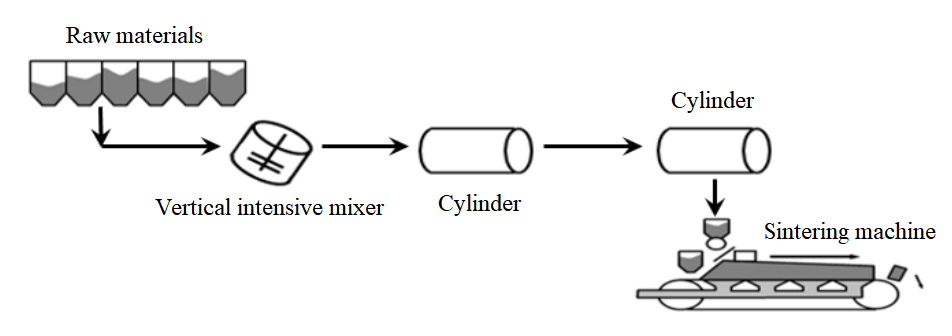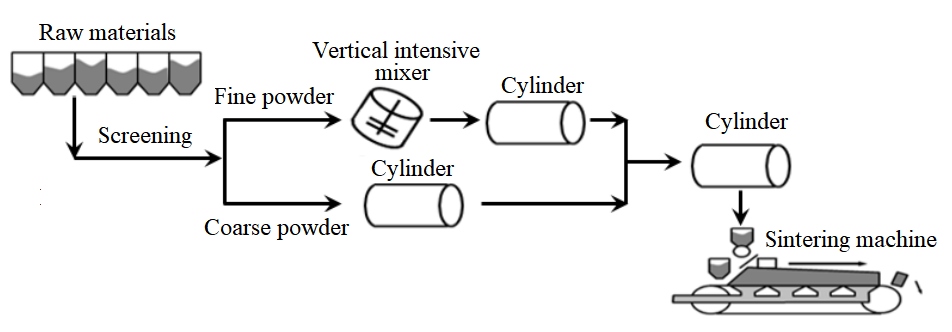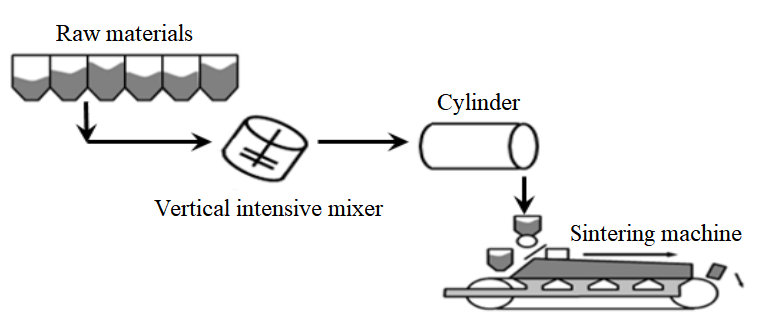Application of vertical intensive mixer in sintering
With the increasing amount of iron ore resources extracted, the rich ore resources have decreased sharply, and the proportion of powdered ore and ultra-fine powdered ore in the sintering raw materials is increasing. Due to the poor hydrophilicity of the sintered fine powder, the traditional cylindrical mixer can easily disperse the water evenly, which in turn makes the fine powder granulation effect poor, leading to the deterioration of sintering production, decreased output, poor quality, and environmental degradation. In the past 20 years, many sintering plants have continued to innovate traditional sinter material preparation technology. Japanese companies such as Sumitomo and Nippon Steel were the first to use vertical intensive mixers for mixing sinter materials. Through research and practice at Sumitomo Wakayama Third Sintering Plant, the use of a vertical powerful mixer instead of a cylindrical mixer has enhanced the mixing effect of the sintered raw materials, and the corresponding granulation effect has also been enhanced, ultimately making the sintered raw materials highly breathable. The sintering speed is increased by 10%~12%, and the coke powder addition ratio can be reduced by 0.5%.
At present, there are three processes for using vertical powerful mixers in sintering, namely the three-stage mixing and granulation process, the coarse and fine screening enhanced granulation process, and the enhanced mixing and granulation process.
1. Three-stage mixing and granulation process
The three-stage mixing and granulation process is shown in Figure 1. In the first stage, a vertical powerful mixer is used for mixing so that the raw materials can be moistened and mixed. In the second and third stages, a cylindrical mixer is used for intensive granulation. Ensure the mix has the right combination of particle sizes and air permeability. Domestic Benxi Iron and Steel Co., Ltd. has adopted this process on a new 566m2 sintering system. After use, the particle size above 3mm has been increased by 20%, and the main exhaust pressure has been reduced by 1000Pa, which has reduced the energy consumption of the sintering plant and increased the profits of the sintering plant.

Figure 1 Three-stage mixing process diagram
2. Coarse and fine screening to strengthen granulation process
The coarse and fine screening enhanced granulation process is shown in Figure 2. The raw materials are screened by a screening machine before mixing. The coarse particles are mixed by a cylinder mixer. The fine powder is mixed by a powerful mixer and then pre-granulated by a cylinder mixer. Finally, a cylinder mixer is used. The cylinder mixer mixes and granulates the two mixtures. The sintering system of the Ghent plant in Belgium was renovated using this process and is currently running well.

Figure 2 Coarse and fine screening enhanced granulation process
3. Strengthen the mixing and granulating process
The enhanced mixing and granulation process is shown in Figure 3. The first stage cylindrical mixer in the traditional two-stage mixing and granulation process is replaced by a vertical powerful mixer, and the second stage still uses a cylindrical mixer for granulation. Since the sintered materials treated by this process have an extremely high degree of mixing, there is no need to premix the raw materials, thus greatly reducing raw material storage space and working area.
In general, the use of vertical strong mixing process in sintering can improve the uniformity of raw materials, enhance the granulation effect, increase the sintering speed, reduce energy and material consumption, and reduce production costs. It is an ideal upgrade technology for the cylindrical mixing process. It can be widely used in the fields of new sintering machines, renovation of old sintering machines, and recycling of dust and sludge in steel plants.

Figure 3 Enhanced mixing and granulation process




